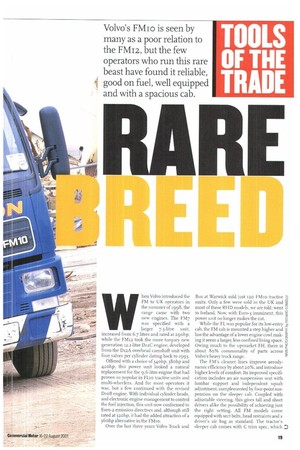VI, hen Volvo introduced the FM to UK operators in the
Page 19

Page 21

If you've noticed an error in this article please click here to report it so we can fix it.
summer 011998, the range came with two new engines. The FM7 was specified with a larger 7.3-litre unit, increased from 6.7 litres and rated at 2,9 ohp, while the FM12 took the more torquey new generation 12.1-litre Dt2C engine, developed from the DizA overhead camshaft unit with four valves per cylinder dating back to 1993.
Offered with a choice of 34ohp, 38ohp and 42ohp, this power unit looked a natural replacement for the 9.6-litre engine that had proven so popular in FL' o tractive units and multi-wheelers. And for most operators it was, but a few continued with the revised Di oB engine. With individual cylinder heads, and electronic engine management to control the fuel injection, this unit now conformed to Euro-2 emission directives and, although still rated at 32ohp, it had the added attraction of a 36ohp alternative in the FMro.
Over the last three years Volvo Truck and
Bus at Warwick sold just 120 FM to tractive units. Only a few were sold in the UK and most of these RH D models, we are told, went 8 to Ireland. Now, with Euro-3 imminent, this E.si power unit no longer makes the cut. C.) While the FL was popular for its low-entry cab, the FM cab is mounted a step higher and has the advantage of a lower engine cowl makg ing it seem a larger, less confined living space. ,b1 Owing much to the upmarket FH, there is about 8o% commonality of parts across
Volvo's heavy truck range.
The FM's cleaner lines improve aerodynamic efficiency by about zo%, and introduce higher levels of comfort. Its improved specification includes an air suspension seat with lumbar support and independent squab adjustment, complemented by four-point suspension on the sleeper cab. Coupled with adjustable steering, this gives tall and short drivers alike the possibility of achieving just the right setting. All FM models come equipped with seot belts, head restraints and a driver's air bag as standard. The tractor's sleeper cab comes with C trim spec, which 0
n incorporates heated rear view mirrors, tinted glass, remote door locking and electric windows, while air conditioning remains on the options list. The driver's air suspended seat has lumbar support in the backrest, and beneath the single bunk there are two storage compartments. One of the more unusual inclusions is a smoke alarm. Both day and Globetrotter cabs are options.
The FMio offers three possible tractor models: the standard 4x2 with four bag air suspension and height control on the drive axle; a low weight 4x2 with a lighter frame and S-leaf spring suspension: and a 6x2 pusher with traction-biased load apportioning, each rated for operation at 38 tonnes.
Volvo's lighter RI4o o transmission is specified for the lower engine rating, while the stronger RI7oo nine-speed, synchromesh, range-change gearbox is fitted to the more powerful option. Both are improved by a 50% lighter lever action and the new CL43S-0 twin plate hydraulic clutch, which reduces pedal effort by around 30%. Volvo's RS1344 SV single reduction drive axle on the two 4x2 configurations is suitable for operation up to 44 tonnes, while the single reduction RAEV9i axle used on the 6x2 is rated for a GVW of 6o tonnes. Common, self-adjusting drum brakes are fitted all round. They may not sound state-ofthe-art, but they do have the advantage of being well tried and tested. An exhaust brake, mounted on the engine manifold, is all the help you get from the engine.
All the FM's connectors and junction boxes are moisture proofed and the wiring runs inside plastic sheaths. Since the mid-eighties Volvo has gradually added to the range of sophisticated on-board electronics, which now control a wide range of components and functions.
Today it is possible for the driver to monitor fuel consumption, oil temperature and ambient temperature. Coolant and washer fluid levels can be checked automatically on start-up, while various parameters, such as PTO speed, can be programmed in to prevent abuse. With all faults recorded between workshop visits, computerised diagnostics make the mechanic's job easier and quicker.
• by INN Brock
























































































































